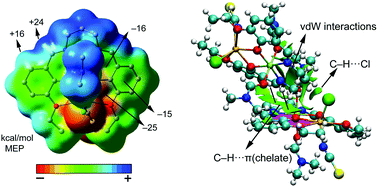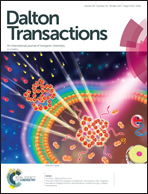Estimation of conventional C–H⋯π (arene), unconventional C–H⋯π (chelate) and C–H⋯π (thiocyanate) interactions in hetero-nuclear nickel(ii)–cadmium(ii) complexes with a compartmental Schiff base†
Abstract
Three new heteronuclear nickel(II)/cadmium(II) complexes, [(SCN)(Cl)Cd(L)Ni(DMF)2] (1), [(SCN)(CH3CO2)Cd(L)Ni(CH3OH)2] (2) and [(SCN)(Cl)Cd(L)Ni(NH2CH2CH2CH2NH2)]n (3) {where H2L = N,N′-bis(3-ethoxy-salicylidene)propane-1,3-diamine is a N2O4 compartmental Schiff base}, have been synthesized and characterized. The structures of the complexes have been confirmed by single crystal X-ray diffraction studies. In each complex, nickel(II) is placed in the inner N2O2 environment and cadmium(II) is placed in the outer O4 compartment of the compartmental Schiff base. Furthermore, the importance of unconventional C–H⋯π (chelate) interactions in the solid state of both complexes and C–H⋯π (thiocyanate) interaction in complex 2 has been described by means of DFT and MEP calculations and characterized using NCI plots. All complexes show photoluminescence at room temperature upon irradiation by ultraviolet light. The lifetimes of excited states are in the range of 2–6 ns.



 Please wait while we load your content...
Please wait while we load your content...